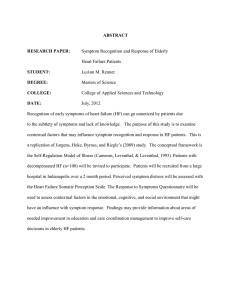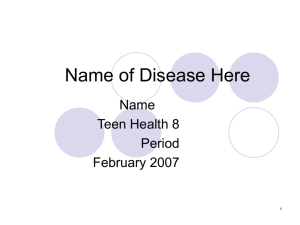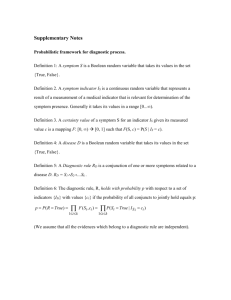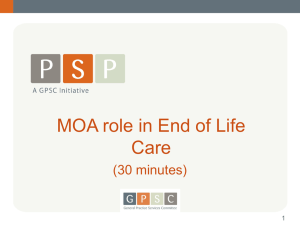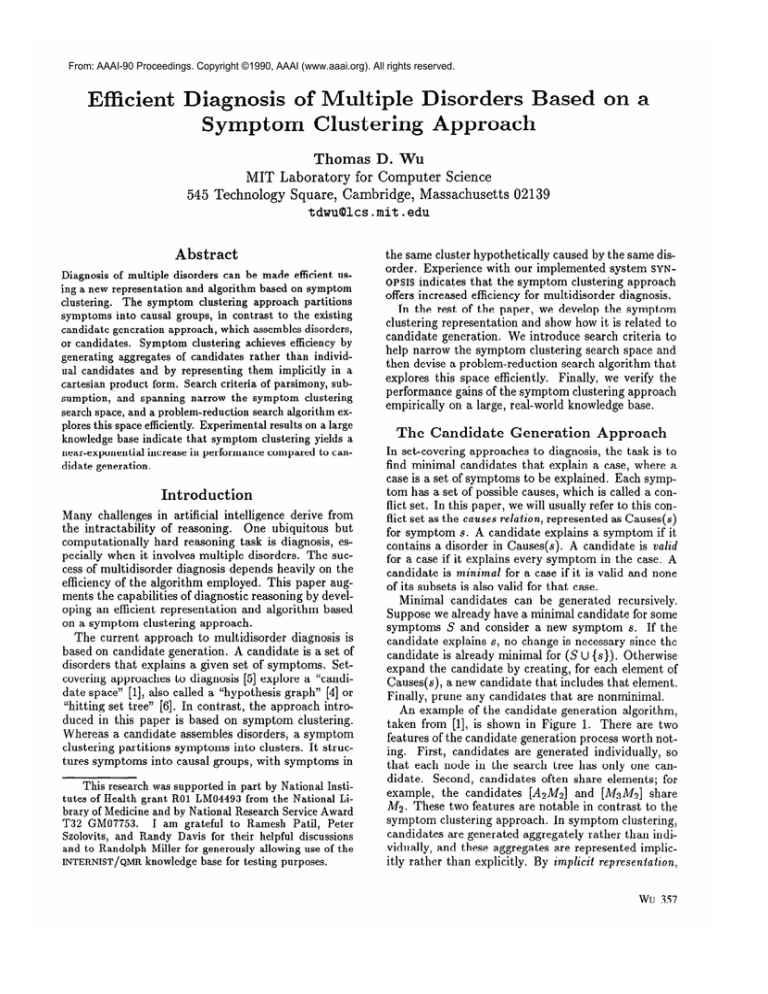
From: AAAI-90 Proceedings. Copyright ©1990, AAAI (www.aaai.org). All rights reserved.
Efficient Diagnosis of Multi
Symptom Clustering
isorders Based
Approach
Thomas D. Wu
MIT Laboratory for Computer Science
545 Technology Square, Cambridge, Massachusetts
tdwu@lcs.mit
.edu
Abstract
Diagnosis of multiple disorders can be made efficient using a new representation and algorithm based on symptom
clustering. The symptom clustering approach partitions
symptoms into causal groups, in contrast to the existing
candidate generation approach, which assembles disorders,
or candidates. Symptom clustering achieves efficiency by
generating aggregates of candidates rather than individual candidates and by representing them implicitly in a
Cartesian product form. Search criteria of parsimony, subsumption, and spanning narrow the symptom clustering
search space, and a problem-reduction search algorithm explores this space efficiently. Experimental results on a large
knowledge base indicate that symptom clustering yields a
near-exponential increase in performance compared to candidate generation.
Introduction
Many challenges in artificial intelligence derive from
the intractability
of reasoning.
One ubiquitous but
computationally
hard reasoning task is diagnosis, especially when it involves multiple disorders. The success of multidisorder diagnosis depends heavily on the
efficiency of the algorithm employed. This paper aug-
ments the capabilities of diagnostic reasoning by developing an efficient representation and algorithm based
on a symptom clustering approach.
The current approach to multidisorder diagnosis is
based on candidate generation. A candidate is a set of
disorders that explains a given set of symptoms. Setcovering approaches to diagnosis [5] explore a “candidate space” [11, a1so called a “hypothesis graph” [4] or
“hitting set tree” [6]. In contrast, the approach introduced in this paper is based on symptom clustering.
Whereas a candidate assembles disorders, a symptom
clustering partitions symptoms into clusters. It structures symptoms into causal groups, with symptoms in
This research was supported in part by National Institutes of Health grant ROl LM04493 from the National Library of Medicine and by National Research Service Award
‘I?32 GM07753.
I am grateful to Ramesh Pat& Peter
Szolovits, and Randy Davis for their helpful discussions
and to Randolph Miller for generously allowing use of the
INTERNIST/QMRknowledge base for testing purposes.
02139
the same cluster hypothetically caused by the same disorder. Experience with our implemented system SYNOPSIS indicates that the symptom clustering approach
offers increased efficiency for multidisorder diagnosis.
In the rest of the paper, we develop the symptom
clustering representation and show how it is related to
candidate generation. We introduce search criteria to
help narrow the symptom clustering search space and
then devise a problem-reduction search algorithm that
explores this space efficiently. Finally, we verify the
performance gains of the symptom clustering approach
empirically on a large, real-world knowledge base.
The Candidate
Generation
Approach
In set-covering approaches to diagnosis, the task is to
find minimal candidates that explain a case, where a
case is a set of symptoms to be explained. Each symptom has a set of possible causes, which is called a con-
flict set. In this paper, we will usually refer to this conflict set as the causes relation, represented as Causes(s)
for symptom s. A candidate explains a symptom if it
contains a disorder in Causes(s). A candidate is valid
for a case if it explains every symptom in the case. A
candidate is minimal for a case if it is valid and none
of its subsets is also valid for that case.
Minimal candidates can be generated recursively.
Suppose we already have a minimal candidate for some
symptoms S and consider a new symptom s. If the
candidate explains s, no change is necessary since the
candidate is already minimal for (S U {s}). Otherwise
expand the candidate by creating, for each element of
Causes(s), a new candidate that includes that element.
Finally, prune any candidates that are nonminimal.
An example of the candidate generation algorithm,
taken from [l], is shown in Figure 1. There are two
features of the candidate generation process worth noting. First, candidates are generated individually, so
that each node in the search tree has only one candidate. Second, candidates often share elements; for
example, the candidates [A2M2] and [A&M21 share
M2. These two features are notable in contrast to the
symptom clustering approach. In symptom clustering,
candidates are generated aggregately rather than individually, and these aggregates are represented implicitly rather than explicitly. By implicit representation,
WV
357
PWWMWWM
x
x
[M3h1[M3Mll[M3M21
x
x
Figure 1: Candidate generation algorithm for a faulty circuit with two symptoms. One symptom can be explained
by adders A1 or AZ or multipliers Ml or Ms. The other
symptom can be explained by AI, MI, or MS. Pruned
candidates, shown with x’s, are nonminimal.
we mean that shared elements are factored completely
into a Cartesian product form. For instance, the explicit representation, [A&f21 and [M&z], can be represented implicitly as a Cartesian product: {AsA&} x
{Mz}. For this small example, the difference may seem
minor, but it can become critical for large knowledge
bases. The implicit representation is much more compact than the explicit representation and helps reduce
one source of combinatorial explosion.
The Symptom
Clustering
Approach
The symptom clustering approach [S] changes the
search space from subsets of disorders to clusterings
of symptoms. A symptom clustering is a partition of
symptoms into clusters. It denotes a possible interpretation of a case, hypothesizing which symptoms are
caused by a common disorder and which by separate
disorders. A disorder explains a cluster if it can cause
every symptom in that cluster. For example, the symptom clustering (ABD)(C) indicates that two disorders
are present: one that explains A, B, and D, and one
that explains C.
The sets of disorders that meet this interpretation
are called di$erentiaZ diagnoses, or simply differentials.
Each differential contains disorders that can explain
one cluster. Differential diagnoses are usually subject
to parsimony criteria, which means that they may be
shaped by the symptoms in other clusters as well as
their own clusters. The Cartesian product of the differential diagnoses implicitly represents an aggregate of
candidates. A more precise definition of differentials
will be presented later in this paper.
The symptom clustering approach offers a novel view
of diagnosis. Whereas candidate generation views diagnosis as the assignment of cause, symptom clustering
views it as the assignment of structure. It tries to determine the best way to decompose a problem, since
a symptom clustering essentially represents a problem
reduction. Its clusters represent the subproblems and
its differentials contain solutions to each subproblem.
Specifically, a symptom clustering may be expressed
as a two-level AND/OR graph, since it contains a con358 COMMONSENSE
REASONING
junction of clusters, and the differential associated with
each cluster contains a disjunction of disorders.
Thus, diagnosis becomes primarily a matter of finding the correct structure for a problem and secondarily a matter of finding the correct causes. Focusing on
structure in diagnosis opens a rich source of heuristics
which might be called structural heuristics; these seem
to be used commonly in everyday reasoning. Detectives often begin by piecing together evidence rather
than trying to identify a culprit for each piece of evidence. In medical diagnosis, problem solving is facilitated by compiled knowledge about clusters of commonly co-occurring symptoms called syndromes.
Another structural heuristic that ties symptoms together
is temporal co-occurrence: symptoms that occur simultaneously are usually related. Structural heuristics
such as these appear to be powerful and widely available. However, exploiting them requires viewing problem solving as the search for structure, a view that is
inherent to the symptom clustering approach.
Relations
between
Representations
In a sense, candidates and symptom clusterings are
duals, since candidates group disorders, while clusterings group symptoms. This duality can be expressed
formally as a satisfaction relation from candidates to
symptom clusterings. Formally, we say that candidate D satisfies clustering C if there exists a complete
matching between clusters in C and disorders in D that
can explain them.
For example, let us postulate a knowledge base containing four symptoms (A, B, C, and D) and seven
disorders (dr , dz, . . . , d7). The causes for each symptom are given below:
Symptom
A
E
D
Causes
(4 &&d4)
(dhW7)
(hW5)
(&&&&)
Then the candidate [d3d5] satisfies the clustering
WWC)
b ecause d3 can explain A, B, and D, while
d5 can explain C.
The inverse of the satisfaction relation is the entailment relation: C entails D if and only if D satisfies
C. We are interested in knowing the set of clusterings
that a given candidate satisfies and the set of candidates that a given clustering entails. In the next two
subsections, we see how to compute these sets.
Computing
the Satisfaction
Relation
The satisfaction relation for a given candidate and case
can be computed as follows. List the possible effects
for each disorder in the candidate. Then select each
symptom in the case once, making sure to select at
least one effect in each list. The selected symptoms
from each list form a cluster in the clustering. For
example, consider the candidate [d&&J:
d3
6
6
-
A
-+
-
D
B
B
A
C
D
B
B
or
D
C
D
(
There are two ways to select the symptoms A, B, C,
and D, as shown in boldface in each of the above ma
trices. These selections correspond to the two clusterings satisfied by [dadgdc], namely, (AB)(C)(D)
and
@DC)@).
In addition to the satisfaction relation, the validity or minimality of a particular case can be determined. Validity testing is simple: Each symptom in
the case must appear in the effects matrix; otherwise,
some symptom cannot be explained. Minimality testing is a bit trickier. Each disorder must have a justification, a symptom in the case that appears in exactly
one effects list. When each disorder has a justification,
the candidate is minimal. For instance, the candidate
[d3d5d6] shown above is not minimal, because d6 lacks
a justification. (Its only effect, D, appears also as a
possible effect of da .) However, removing d6 yields a
minimal candidate:
d3
-
hi
-
A*
B
B
D*
To compute M-entailment, we use exception filtering.
This process removes exceptions from causal intersections to yield differential diagnoses. An exception is a
disorder that does not appear in any of the minimal
candidates entailed. To find and remove exceptions
from causal intersections, we use filters. A filter is essentially a cross-cluster constraint: A filter for each
cluster identifies exceptions in other clusters. A filter
is composed of subfilters, each subfilter deriving from a
symptom in the associated cluster. The subfilter represents a situation where its corresponding symptom is
a justification; it contains disorders inconsistent with
this assumption. However, we may discover that some
symptoms cannot be justifications; they impose such
strong constraints that they would eliminate all disorders in some other cluster. The subfilters for these
symptoms are called infeasible. Hence, an exception is
a disorder appearing in every feasible subfilter of some
filter. The algorithm for exception filtering follows:
Initialize: For each cluster c, initialize its differential
to be its causal intersection. For each symptom s in
c, initialize its subfilter to be the intersection of s
with all disorders in other differentials:
Diff( c)
C*
Subfilter
Each disorder has a justification (shown as starred), so
[dsds] is minimal.
Computing
the Entailment
Filter(c)
Relation
The inverse of satisfaction is entailment:
Given a
symptom clustering, what are all candidates that satisfy it? Actually, we may be interested in finding either valid candidates or minimal candidates that satisfy the clustering. Thus, we need two entailment relations: V-entailment to obtain valid candidates and
M-entailment to obtain minimal candidates.
The V-entailment relation can be computed as follows. Given a clustering, find the causal intersection
for each cluster c, by intersecting the possible causes
for each symptom s in that cluster:
Int(c)
=
n Causes(s)
SEC
[Wrid4], [d&id&
[&dd4], [&d&],
[dd&],
[hd&],
[&d&]
[W&],
[&Wl],
[&&&],
Int(c)
t
Causes(s) n U Diff(c’)
c’fc
+-
{Subfilter
] s E c}
Remove infeasible subfilters: A subfilter f for a cluster c is infeasible if it subsumes another differential.
Remove infeasible subfilters from each filter:
Infeasible(f)
_
Filter(c)
3~’# c. f ,> Diff(c’)
+
Filter(c) - {f ] Infeasible(f))
At this point, every filter must have at least one
feasible subfilter. If not, then the clustering entails
no minimal candidates.
Remove exceptions: Find exceptions for each filter
by taking the intersection of its subfilters. Remove
these exceptions from all differentials and subfilters:
The valid candidates are then the Cartesian product
of the causal intersections, excluding sets with duplicate elements. This exclusion ensures that the number of disorders (cardinality) in the candidate equals
the number of clusters (dimension) in the clustering.
For example, consider the clustering (AC)(B)(D).
The
causal intersections of the three clusters are {dldz),
{dld3d5d7},
and (dld3d4d6),
respectively, yielding 22
valid candidates:
V-entails((AC)(B)(D))
=
khW41, [dld&], [W&],
[kh-bl, [ddvk], [&&&],
kW&],
[h-k&], [&&dl],
[&d741, [&&&I, [d&d4],
+
WC)
+-
f-J
f
f~Filter(c)
Diff( c)
Subfilter
Filter(c)
+-
Diff(c) - U Exe(c)
+
Subfilter(s; - U EXC(C)
c-
{Subfilter
] see c)
Terminate: If no exceptions were found in the last
step, halt. Else repeat step 2, since the smaller differentials may have made more subfilters infeasible.
An
example
of
this
process
for
the
cluster
wu
359
Int(ci)
/Exceptions
Remaining
FiIter(c1)
Figure 2: Geometric interpretation of symptom clusterings.
A symptom clustering with n clusters bounds a region in
n-dimensional candidate space. Minimal candidates entailed by a clustering are points within the shaded region.
Causal intersections define the outer boundary; differentials
define the inner boundary. Exception filtering removes exterior regions of nonminimality and represents interior regions implicitly.
w3(BP)
is shown below:
aggregately instead of individually. This allows entire
sets of candidates to be pruned simultaneously. Second, these aggregates are represented implicitly. Analogously, we compute the boundaries of a candidate region, rather than every point in the volume. Finally,
minimal candidates are computed convexly. This allows internal regions of nonminimality to remain in the
differentials, thereby maintaining the n-dimensional
cubic shape of the aggregates.
To a first approximation, we expect symptom clustering to achieve exponential time and space savings
over candidate generation. If each symptom clustering has n clusters and each differential has a geometric
mean of V disorders, each clustering entails approximately DDncandidates. However, the exact savings are
difficult to determine, because some of the candidates
are not minimal and because a candidate may satisfy
more than one symptom clustering. Nevertheless, experimental results presented later lend support to a
near-exponential increase in performance.
Search Criteria
Even with an more efficient representation, the symptom clustering search space can still grow rapidly.
Thus, we impose additional criteria to help prune the
search space, namely, parsimony, subsumption, and
spanning. Parsimony is a preference for simplicity,
subsumption minimizes unwarranted constraints, and
spanning avoids redundant solutions.
Clusters
03)
Parsimony
The minimal candidates are contained within the
Cartesian product of these differentials. Here, the differentials are (d2}, {dgd7}, and {d4d6), with a cartesian...product of [d2dsd4], [dzdsd6], [dzdTd4], [dzdTd6].
But :the remaining exception filter (( { d4) (ds))) specifies that candidate [dsdsdd] is nonminimal because it
contains
an element from each subfilter.
The minimal
candidates are therefore
M-entails((AC)(B)(D))
= [&h-k],
[4&&],
[&&&]
Note that these three candidates cannot be factored
into a single implicit representation.
Exception filtering handles this by representing minimal candidates in
two implicit parts: differentials and filters. Although
differentials may contain
some nonminimal
candidates
in their Cartesian product, this enables them to represent the minimal candidates more economically. Thus,
exception filtering achieves efficient representation by
ignoring details about minimality that would fragment
aggregates of candidates.
Geometric
Interpretation
The relationship between symptom clusterings and
candidates is shown geometrically in Figure 2. As illustrated, the efficiency of symptom clustering results
from three sources. First, candidates are generated
360 COMMONSENSE
REASONING
Parsimony is a preference for simplicity in explanations. In candidate generation, the criterion of parsimony typically used is minimality. Likewise, the symptom clustering approach can adopt parsimony criteria,
such as validity and minimality, to help reduce search.
We define a symptom clustering to be valid (likewise
minimal) if it V-entails (M-entails) at least one candidate:
Valid(C)
_
V-entails(C)
# 0
Minimal(C)
-
M-entails(C)
# 0
Determining whether a clustering is valid or minimal can be accomplished by the entailment procedures
given previously.
Subsumption
In addition to parsimony, symptom clustering can reduce search by exploiting subsumption. Subsumption
occurs when a more general model or concept contains
a more specific one. Subsumption applies in symptom
clustering because the candidates entailed by one clustering may be a subset of those entailed by another
clustering. Since both clusterings represent valid interpretations of the data, the more specific clustering
is constrained unnecessarily by having its symptoms
allocated to the “wrong” clusters. In the absence of
any other information, we should therefore prefer the
more general clustering, because it represents only constraints that are minimally necessary.
We say that clustering Cl subsumes C2 if there exists
a complete matching between their causal intersections
under the superset relation, that is, if each causal intersection in Cl is a superset of some corresponding
causal intersection in 62. Clusterings (5’1 and C2 are
equigeneral if there exists a complete matching under
set equality. Finally, Cl properly subsumes C2 if Cr
subsumes C2 but they are not equigeneral. These definitions lead to the subsumption criterion of generality:
A clustering is general for a given case if no other valid
clustering properly subsumes it. In the geometric interpretation given above, a clustering is general if its
outer boundary is not enclosed by any other clustering.
This definition of generality can be computed readily
using a process of symptom rearrangement.
In symptom rearrangement, if a clustering is not already general, symptoms are moved between clusters until it is
general. The conditions for moving a symptom between clusters can be expressed in terms of the following concepts. We say that a symptom s constrains a
cluster c if it directly reduces its causal intersection,
that is, if the possible causes for s do not subsume the
causal intersection of (c - {s}):
Constrains(s,c)
_
Causes(s) 2 Int(c - {s))
A contrary notion is covering. We say that a symptom
s covers a cluster c if its possible causes subsume the
causal intersection of that cluster:
Covers(s, c)
*
Causes(s) ,> Int(c)
Finally, a symptom s in cluster cl is movable to another cluster c2 if it constrains cl and covers ~2. (For
definitional purposes, a symptom cannot move out of
a singleton cluster.)
The key to symptom rearrangement is this theorem:
A cluster is general if and only if all of its symptoms are not movable. This theorem yields a procedure to turn nongeneral clusterings into general ones:
Simply move all movable symptoms until generality is
obtained. This process must terminate because each
movement of s from cl to c2 has no effect on the causal
intersection of c2 but enlarges the causal intersection
of cr. At some point, the growth of causal intersections
must halt.
For example, consider the clustering (AB)(CD)
which has causal intersections {dl) and {dlds}.
This
is not general because A is movable from cl to c2 and
D is movable from c2 to cr. If we move A forward, we
whic h is general (but not minimal). If
get WWD>,
we move D backward, we get (ABD)(C), which is also
general (and minimal). This example reveals that the
rearrangement procedure is nondeterministic, a fact we
will account for when we devise an algorithm to explore
the search space.
Spanning
Spanning attempts to find a representative group of
solutions by eliminating those that are redundant. Redundancy occurs in symptom clustering because some
symptoms may be placed in several clusters without
affecting the set of candidates entailed. Whenever the
causes for a symptom are broad enough to covers more
than one cluster, that symptom can be placed arbitrarily; each placement results in an equigeneral clustering. This redundancy is especially undesirable because
broad symptoms have little discriminatory power. We
seek to avoid this redundancy by generating only one
clustering from each class of equigeneral clusterings.
This yields a spanning set of general clusterings.
For example, suppose symptom E has possible
Consider clustering (AD) (BC) ,
causes ( dld3d4d5).
which has causal intersections of {dldsdg}
and {dlds}.
Symptom E covers either cluster, so that (ADE)(BC)
and (AD)(BCE)
are equigeneral.
A spanning set
would include either (ADE)(BC) or (AD)(BCE) but
not both.
Problem-Reduction
Search
The criteria given above define a set of clusterings that
we would like to generate, namely a spanning set of
general, minimal clusterings for a given case. We now
present an algorithm that generates these clusterings.
This algorithm is called problem-reduction search because it is a state-space search with each node of the
search tree being one possible symptom clustering. As
we mentioned before, a symptom clustering represents
a problem-reduction, so this algorithm combines the
features of both the problem-reduction and the statespace representations.
The algorithm processes one symptom in the case at
a time. The first symptom can be clustered in only one
way, a single cluster, yielding a frontier with a single
clustering. The clusterings in each frontier are then
expanded by another symptom from the case until all
symptoms have been processed. Expansion consists of
three steps: allocating a symptom to a cluster, rearranging the symptoms to achieve generality, and pruning nonminimal and equigeneral clusterings.
Allocating
Symptoms
Symptom s may be allocated to a cluster in four ways:
Put s into a cluster c that it covers. Precondition: Covers(s, 4.
Restricting:
Put s into a cluster c that it would constrain. Precondition: Constrains(s, c).
Covering:
Add a cluster consisting only of s. Precondition: Causes(s) - U, Int(c) # 0.
Adding:
Add a cluster consisting of s and a
symptom s’ already in some cluster c’ that would
Precondition:
Constrains(s’, c’) A
constrain it.
Constrains(s’, {s}).
Extracting:
WV 361
Only some of these allocations need be performed for a
given symptom and clustering. If some covering allocation is possible, the allocation process is finished. Else,
all restrictions, additions, and extractions meeting the
preconditions are invoked.
For example, Figure 3 shows problem-reduction
search for symptoms A, B, C, and D in our running
example. All four types of allocation, shown on each
arc, are illustrated for symptom D. Node (ABCD)
comes from covering (ABC); (AD)(BC) from restricting (A)(BC); (A)(BC)(D)
from adding to (A)(BC);
and (C)(B)(AD)
from extracting A from (AC)(B).
Rearranging Symptoms
After allocating symptoms, they may need to be rearranged. However, as we mentioned previously, rearrangement can be nondeterministic.
This presents
problems in creating a spanning set of clusterings. Two
sibling clusterings in the same frontier could rearrange
to form the same clustering, thereby duplicating one
clustering while failing to generate another one. We
can eliminate this nondeterminism and create a spanning set by specifying exactly how symptoms should
be rearranged. These techniques are called incremental and coordinated rearrangement.
Incremental rearrangement assumes that a clustering is general before allocating a new symptom and
that nongenerality may be introduced during alloca,
tion. The specific source of nongenerality can then
be repaired. Nongenerality can be introduced in three
ways: (1) Reducing a causal intersection for cluster c
enables symptoms in other clusters to move into c. (2)
Adding a cluster c enables symptoms in other clusters
to move into it. (3) Enlarging a causal intersection for
c enables to symptoms in c to move to other clusters.
Thus, allocating a symptom can introduce nongenerality as follows: Covering has no effect; restricting or
adding a cluster enables that cluster to import symptoms from other clusters; and extracting a symptom
from cluster c’ to create cluster c enables c’ to export
symptoms and c to import symptoms. We must also
consider the secondary effects of moving symptoms.
Moving a symptom from cl to c2 enlarges the causal
intersection of cl, enabling cl to export symptoms, but
has no effect on ~2.
Incremental rearrangement is performed in two
stages: an importing stage and exporting stage. Suppose that cluster c has been restricted, added, or newly
created by extraction. In the importing stage, c imports all symptoms that are eligible to move to it.
Then in the exporting stage, any cluster that has exported a symptom exports any other symptom that
can now move out. For extraction, the cluster with
the extracted symptom originally also counts as an exporting cluster.
Figure 3 illustrates an example of rearrangement,
indicated by the starred arc. Symptom D initially
restricts clustering (AC)(B) to give (AC)(BD). Incre362 COMMONSENSEREASONING
mental rearrangement imports symptom A to the restricted cluster, giving (C)(ABD).
In the exporting
stage, cluster (C) h as no symptoms to export, so rearrangement is complete.
Incremental rearrangement handles most cases of
nondeterminism.
Nevertheless, the exporting stage
may still be nondeterministic, because exporting from
cl to c2 may preclude an export from cs to cl. We say
that these two movements confEict. Movement conflicts
can be resolved by a coordinated rearrangement strategy. Coordinated rearrangement assumes that clusters are maintained in order of their creation. When
two movements conflict, we favor a forward movements
(from earlier clusters to later ones) over backward ones.
Thus, in our example, if cl is before cs, then movement
cs + cl is backward, and cl + c2 takes precedence.
If cs is before cl, then conflict can be avoided by performing cs + cl before cl 3 ~2.
This bias for forward movements depends on other
parts of the search tree to explore missed opportunities
that would have been generated by backward movements. To avoid foreclosing these opportunities prematurely, we also need a least-commitment strategy,
whereby symptoms are moved to the earliest cluster
possible, if there is more than one. Covering allocations must also adhere to the least-commitment strategy, so a symptom is allocated to the first cluster it
covers, if any.
Coordinated rearrangement can be implemented
easily. In the exporting stage, export from clusters
in forward chronological order. For each constraining
symptom in an exporting cluster, move it to the first
cluster that it covers, if any. This may mean that a
symptom moves backward, but this backward movement will not conflict with any forward movements,
since earlier clusters will have already exported.
Pruning
After a clustering has been expanded and rearranged
if necessary, its differentials are computed using the
exception filter procedure discussed previously. If any
filter lacks a feasible subfilter or any differential becomes null, that clustering is pruned.
In addition to nonminimal clusterings, redundant
equigeneral clusterings must also be pruned. This can
be done by comparing clusterings pairwise to check
for equigeneral clusterings. This comparison will also
uncover any duplicate clusterings that can arise. For
example, in Figure 3, the clustering (ABD)(C) is generated twice, so one duplicate can be removed.
Experimental
Results
Candidate generation and symptom clustering algorithms were implemented in Common Lisp on
a Symbolics Lisp Machine and applied to the INTERNIST/QMR knowledge base [3]. This knowledge
base contains 600 diseases and 4300 symptoms, covering 70% of the knowledge in internal medicine. To
btsMd5d71
{did31
Figure 3: Problem-reduction search algorithm. The four symptoms, A, B, C, and D, correspond to the example given in the
text. Each node shows a clustering and its differentials, along with any remaining exception filter. Arcs are labeled with the
type of allocation: Covering, Restricting, Adding, or Extracting. A star indicates that rearrangement was performed.
control for effects of case variation and symptom ordering, we decided to analyze a single disease profile in
depth. Prerenal azotemia was chosen because it generated relatively few symptoms (14, excluding age and
sex), and these triggered various numbers of possible
causes. The sets of possible causes ranged in size from
2 to 76, with a median of 29. The union of possible causes contained 147 diseases, meaning that a sub-
graph of 147 diseases and 14 symptoms was selected
for this experiment.
Ten test cases were generated stochastically, by randomly selecting from the 14 symptoms for prerenal
azotemia. These test cases contained 7-12 symptoms
each. The probability of selecting a symptom depended on its frequency value: a frequency value of
1 resulted in a 3% chance of selection; 2, 20%; 3,
50%; 4, 80%; and 5, 98%. Contextual symptoms of
age and sex were excluded, since the knowledge base
lists all 600 disease as possible “causes”, which would
have severely penalized the candidate generation algorithm. However, we made no other checks for medical
accuracy. In particular, some test cases contained two
values for the same test, such as a blood urea nitrogen
level of both 30-59 and 60-100 mg/dl, or a creatinine
level of both 1.5-2.9 and 3-10 mg/dl. A reasonable interpretation of these readings is the common situation
of testing a patient multiple times.
Solving each of the ten test cases for minimal candidates, we obtain six categories of solutions, ranging
from 27 to 39101 minimal candidates. Although cases
were generated from a single disease, minimal candidate solutions contained 1 to 5 disorders, with the following distributions:
Category
A
i?
D
E
F
Candidates by Cardinality
I2
3
4
5
Total
27
1
1
25
73
1
0
39
33
1
0
11
100
112
1
0
6
165
165
337
1 11
85
435
15
547
1 21 769 8985 29325 39101
The number of minimal clustering solutions ranged
from 3 to 10, with the following size distributions:
Category
A
i?
D
E
F
1 Clusterings by Dimensions
1
2
3
4
5
1
1
1
102 0
1
3
1
1
1
11
0
2
1
2
3
3
1
4
1
1
1
1
Total
3
4
5
6
7
10
We generated ten runs for each case by randomly
permuting the order of the symptoms, and running
times and search tree sizes were measured for each
run. Any candidate generation run requiring more
than lo5 seconds (27.8 hours) was terminated. This
eliminated 3 of the 40 runs in category A, 6 of the 20
runs in D, and all 10 runs in F. These cases are not
shown on our graphs, but were solved by the symptom clustering algorithm in an average of 161 seconds.
Figure 4 compares run times and search tree sizes.
-We see that symptom clustering is substantially
faster and more space-efficient than candidate generation. The roughly linear relationship on a log-linear
scale indicates a near-exponential increase in performance, agreeing with the theoretically predicted reWu 363
Search Tree Size (nodes)
Run Time bed
E
0
‘;
E
fz
50
1
10
100
Candidate
1000
10000
Figure 4: Comparison
of candidate
is the total nodes over all frontiers
scatterplot
smoothing.
scale>
cial intelligence deals primarily with problems that are
ill-structured [7]. This paper suggests, at least for the
domain of diagnostic problem solving, how the explicit
assignment of structure might facilitate the solution of
ill-structured problems.
and Further Research
This paper shifts the problem representation for multidisorder diagnosis from candidates to symptom clusterings. It establishes satisfaction and entailment relations between candidates and symptom clusterings,
and defines criteria of minimality, generality, and spanning. The paper then devises an efficient algorithm to
compute all symptom clusterings satisfying these criteria. Finally, the theoretical work is supplemented
with empirical results that suggest a near-exponential
increase in performance for symptom clustering.
This work presents several opportunities for further
research. It offers a new representation for exploring
novel types of search strategies, probabilistic theories,
and heuristic sources. In particular, symptom clustering could potentially exploit “structural heuristics”information about plausible groupings of evidencewhich constitute a promising source of domain-specific
knowledge.
Other fields of artificial intelligence besides diagnosis might benefit from the concepts here. For instance,
previous research on learning and discovery systems [2]
has also investigated clustering representations. Multidisorder diagnosis is closely related to the problems of
multiple constraint satisfaction, conjunctive-goal planning and truth maintenance. Thus, some analogous
notion of “constraint clustering” or “goal clustering”
might be used effectively for these problems. Artifi-
364 COMMONSENSEREASONING
(10~
generation
and symptom
clustering for run times and search tree size. Search tree size
after pruning.
Letters correspond
to the case category.
Lines represent locally weighted
sults. As the problems become more difficult, however,
these savings diminish somewhat, perhaps indicating
the overhead of symptom clustering or other sources
of computational complexity.
Conclusions
Candidate Generation
Generation (log scale)
100000
10000
1000
100
100000
References
PI
J. de Kleer and B. C. Williams.
Diagnosing
multiple
faults. Artijkial
Intelligence, 32:97-130, 1987.
PI
D. Fisher
clustering.
and P. Langley.
In Proceedings,
Conference
on Artificial
Approaches
to conceptual
Ninth International
Joint
Intelligence,
pages 691-697,
1985.
PI
R. A. Miller, M.
l/Quick
Medical
PI
Y. Peng and J. A. Reggia. A probabilistic
causal model
for diagnostic
problem solving. IEEE Transactions
on
Systems, Man, and Cybernetics, 17:146-162
and 395406, 1987.
Fl
J. A.
nostic
Western
Journal
A. McNeil,
et al.
The InternistR e f erence
project-status
report.
of Medicine, 145:816-822,
1986.
Reggia,
D. S. Nau, and P. Y. Wang.
expert systems based on a set covering
Intl. Journal
1983.
of Man-Machine
Studies,
19:437-460,
PI
R. Reiter.
A theory
of diagnosis
Artificial
Intelligence,
32:57-96,
VI
H. A. Simon.
PI
T. D. Wu. Symptom
clustering
and syndromic
knowledge in diagnostic
problem
solving.
In Proceedings,
Artificial
from
Diagmodel.
first principles.
1987.
The structure
of ill-structured
4:181-201,
1973.
problems.
Intelligence,
Thirteenth Symposium
on Computer
Medical Care, pages 45-49, 1989.
Applications
in

